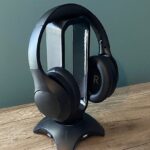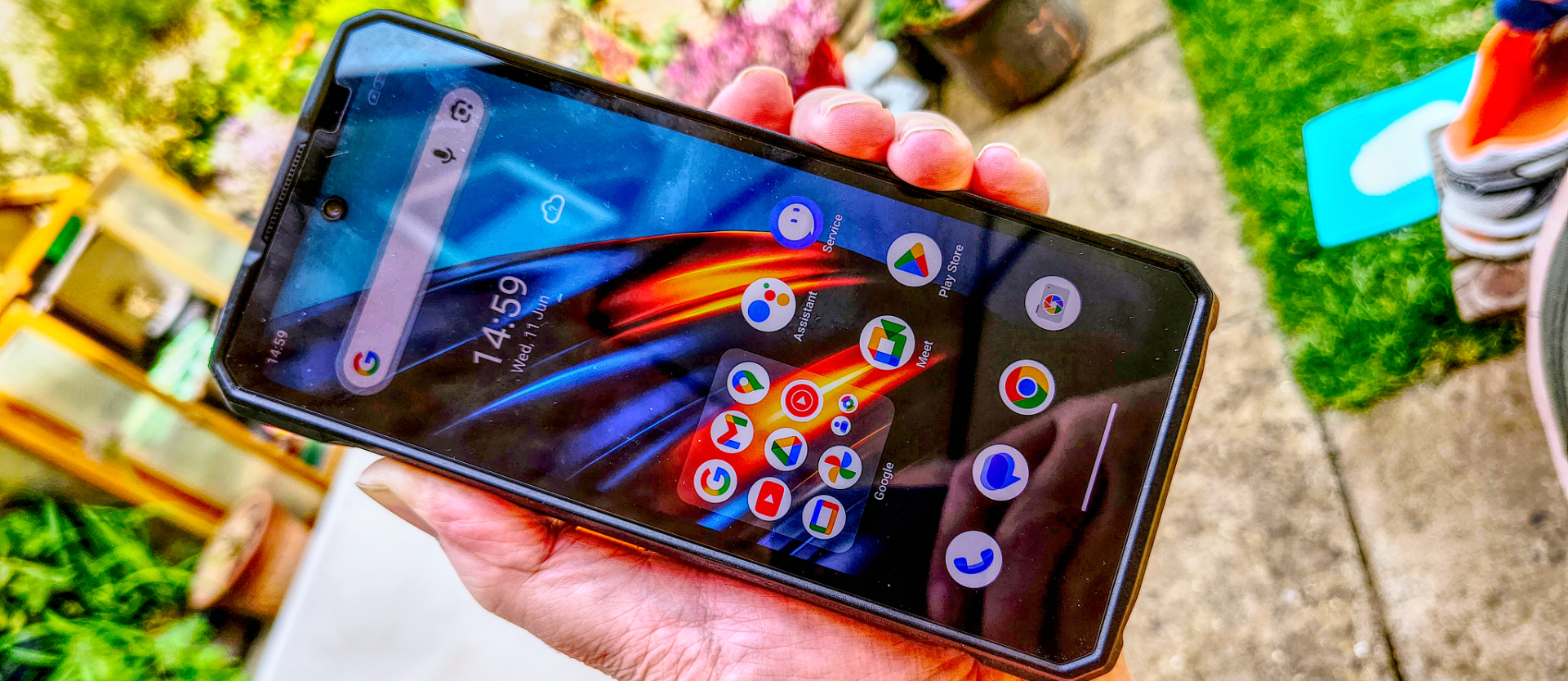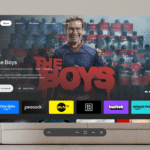Why you can trust TechRadar
We spend hours testing every product or service we review, so you can be sure you’re buying the best. Find out more about how we test.
Ulefone Armor 33 Pro: 30-second review
Where some rugged phone designers try to make them as much like everyday designs as they can, others forget that people have pockets and a limited carrying capacity and make things like the gargantuan Ulefone Armor 33 Pro.
In essence, this is exactly the same hardware as the Ulefone Armor 30 Pro I recently reviewed (read it here), with the same processor, screens, memory, storage, cameras and features.
However, it has one significant difference. Whereas the 30 Pro had a 12800 mAh battery capacity, the 33 Pro boasts a whopping 25500 mAh, nearly double the capacity.
That extends its running time away from a charging point to more than three entire days of constant use, and if curated, this phone could easily last a week or more.
The catch to having that much battery is that it increases the phone’s weight by nearly 50%, making it even more challenging to put (and keep) in a pocket, and even less likely something you would want to take on a long hike.
Where the 30 Pro was borderline practical, this extra mass pushes the 33 Pro into a place where the only considered deployment is one where it’s mounted to a vehicle.
It’s too niche to make it into our best rugged phone round-up, but it’s an interesting option for those who need excessive battery life.
Ulefone Armor 33 Pro: price and availability
- How much does it cost? TBA
- When is it out? Available now
- Where can you get it? Direct from the maker or via an online retailer
Ulefone appears to have got its ducks entirely out of order, and has launched the Armor 34 Pro before releasing this 33 Pro, confusingly.
You can pick it up from the official Ulefone site by clicking here. I’m also seeing it on Amazon.com and Amazon.co.uk.
Currently, it’s retailing for around $500 / £400.
Ulefone Armor 33 Pro: Specs
|
Item |
Spec |
|
CPU: |
MediaTek Dimensity 7300X |
|
GPU: |
Arm Mali-G615 MC2 |
|
NPU: |
MediaTek APU 655 |
|
RAM: |
16GB |
|
Storage: |
512GB |
|
Screen: |
6.95-inch AMOLED 700 nits 120Hz + AMOLED 3.4 600 nits 60Hz |
|
Resolution: |
1080 x 2460 and 412 x 960 pixels |
|
SIM: |
2x Nano SIM + TF (all three can be used) |
|
Weight: |
785 grams |
|
Dimensions: |
185.5 x 85.5 x 34 mm |
|
Rugged Spec: |
IP68 IP69K dust/water resistant (up to 2m for 30 min), MIL-STD-810H Certification |
|
Rear cameras: |
50MP OV50H + 64MP OV64B Night Vision + 50MP JN1 Ultra wide-angle |
|
Front camera: |
32MP Samsung GD2 |
|
Networking: |
WiFi 6, Bluetooth 5.3 |
|
OS: |
Android 15 |
|
Battery: |
25500 mAh (Max 66W wired, 10W reverse) |
|
Colours: |
Black |
Ulefone Armor 33 Pro: design
- Just like the 30 Pro but bigger
- Buoyancy of the iceberg modified Titanic
In a dark and grimy alley, you are confronted by a knife-wielding maniac. What to do? You cuff them about the ear with the Armor 33 Pro, ending that confrontation abruptly.
I won’t break down the design of this phone in great detail because it’s practically identical to the 30 Pro, with one notable exception.
That difference is that the case was increased in depth from 21.2 mm to a waistline-challenging 34 mm to accommodate doubling the battery capacity.
The result of that modification is not only a longer operating life, but it also increased the weight of the device from 509 grams on the 30 Pro to a please-don’t-swim-with-this 785 grams.
If, as I’m sure some of you are wondering, if perhaps a supermodel were to throw this at an unsuspecting aide and hit them anywhere vital, it would surely kill them. But if they avoided being prosecuted, they’d have an alternative career in the sport of shot put.
It’s so big and thick that it won’t easily fit into a jacket pocket, and is an alternative to a weight belt for anyone who scuba dives.
In all other respects, it is identical to the 30 Pro, including button placement, the uSmart adapter, the 3.5mm audio jack, and the second 3.4-inch screen on the back.
I recall questioning the practicality of the 30 Pro at a little over 500g, but this is a device that rivals the very first mobile phones that came in a suitcase.
It might be argued that, from a design perspective, the engineers who developed this concept executed the brief perfectly, and they undoubtedly did. However, that doesn’t make it something most people would want to have about them.
Design score: 4/5
Ulefone Armor 33 Pro: hardware
- MediaTek Dimensity 7300X
- OLED displays
- 25500 mAh battery
The Dimensity 7300X is a reasonably powerful SoC with 5G comms and a decent Arm Mali-G615 MC2 GPU. There is also an NPU, if you like local AI.
That’s more than enough performance for the typical Android user, and with the exception of some incredibly demanding games, the video performance is great.
Taking the headline feature of the 30 Pro, this phone has a striking OLED 6.95-inch main display protected by Corning Gorilla Glass 5, and another smaller 3.4-inch screen on the back with a lower resolution.
What’s wacky about the second display is that it can be used in exactly the same way as the primary screen, as it has a touch sensor that allows the launching and control of apps.
An issue with both displays is their glossy nature, resulting in copious reflections in bright outdoor conditions. Some anti-glare coating or film is mandatory for outdoor workers.
But as nice as the dual screens are, it isn’t the reason anyone might want this model. That would be the 25500 mAh battery capacity, almost double that of the 12800 mAh in the 30 Pro.
By my estimates, this would enable the 33 Pro to last a whopping 1350 hours on standby (approximately two months) and engage in a modest 135-hour-long call.
The box includes a 66W charger, but due to its capacity, it takes twice as long to charge from zero as the 30 Pro, approximately five hours.
Overall, the battery and its added weight cast a significant shadow over the other generally positive aspects of this device. If all you want is battery life, then this is a better option than the 30 Pro, but it does come with some significant drawbacks.
Ulefone Armor 33 Pro: cameras
- 50MP, 64MP and 50MP sensors on the rear
- 32MP on the front
- Four cameras in total
The Ulefone Armor 33 Pro has four cameras:
Rear camera: 50MP OV50H primary, 64MP OV64B Night Vision , 50MP JN1 Ultra wide-angle
Front camera: 32MP Samsung GD2
To keep this brief, this is an identical camera cluster to the 30 Pro. To summarise, the sensors in this phone aren’t cutting-edge, but they are decent.
As a result, it is possible to take some good pictures with this phone. And that it uses the excellent JN1 merely for ultra-wide shooting, when other phones have this as the primary camera, speaks volumes.
However, I need to warn you about one camera feature that could be dangerous in the wrong situation. Ulefone has made this phone waterproof to a depth of at least 2m for 30 minutes, and to support this capability, it features an underwater shooting mode.
My concern is that this phone has sufficient weight that a child or older person might find it impacts their natural buoyancy should they get into difficulties in deep water. While using a wrist strap on this phone is possible, as it has an eyelet to attach one, this might not be the phone to install it on, even if that means the loss of the phone.
I always question underwater modes because it’s so easy to exceed the maximum depth and ruin the phone, but with the 33 Pro, there might be another good reason for not using it.
Like all the recent Ulefone devices I’ve reviewed, this one supports Widevine L1 video encryption, enabling the best quality streams from mainstream content providers, such as Netflix or Disney+.
Ulefone Armor 33 Pro Camera samples
Ulefone Armor 33 Pro: performance
- Decent SoC
- GPU is game-friendly
- Large battery
|
Phone |
Header Cell – Column 1 |
Ulefone Armor 33 Pro |
Ulefone Armor 30 Pro |
|---|---|---|---|
|
SoC |
Row 0 – Cell 1 |
Dimensity 7300X |
Dimensity 7300X |
|
GPU |
Row 1 – Cell 1 |
Mali-G615 MC3 |
Mali-G615 MC2 |
|
Mem |
Row 2 – Cell 1 |
MediaTek NPU 656 |
MediaTek NPU 655 |
|
NPU |
Row 3 – Cell 1 |
16GB/512GB |
16GB/512GB |
|
Weight |
Row 4 – Cell 1 |
785g |
509g |
|
Battery |
Row 5 – Cell 1 |
25500 |
12800 |
|
Geekbench |
Single |
1038 |
1030 |
| Row 7 – Cell 0 |
Multi |
3207 |
3269 |
| Row 8 – Cell 0 |
OpenCL |
2510 |
2509 |
| Row 9 – Cell 0 |
Vulkan |
2492 |
2502 |
|
GFX |
Aztec Open Normal |
40 |
36 |
| Row 11 – Cell 0 |
Aztec Vulkan Norm. |
42 |
42 |
| Row 12 – Cell 0 |
Car Chase |
36 |
36 |
| Row 13 – Cell 0 |
Manhattan 3.1 |
61 |
61 |
|
PCMark |
3.0 Score |
11240 |
11282 |
| Row 15 – Cell 0 |
Battery |
46h 22m |
26h 38m |
|
Charge 30 |
% |
21 |
42 |
|
Passmark |
Score |
14762 |
5033 |
| Row 18 – Cell 0 |
CPU |
7198 |
2140 |
|
3DMark |
Slingshot OGL |
7199 |
7238 |
| Row 20 – Cell 0 |
Slingshot Ex. OGL |
5439 |
5446 |
| Row 21 – Cell 0 |
Slingshot Ex. Vulkan |
3793 |
3814 |
| Row 22 – Cell 0 |
Wildlife |
3284 |
3284 |
| Row 23 – Cell 0 |
Nomad Lite |
358 |
360 |
The underlying platform of this phone is the same as the Armor 30 Pro, making the majority of these benchmarks almost identical.
However, there are some differences, and those are centred on battery life.
While it didn’t deliver double the running time with almost twice as much capacity, it did extend the running time to a level where, without constant use, this phone might last a week.
But it also takes longer to recharge, so forgetting to attach this phone to the charger could have significant implications.
Due to the mass of this phone, it would work well if mounted in a vehicle, but unless you are feeling especially fit, it isn’t something you would want to carry on a long hike.
Ulefone Armor 33 Pro: Final verdict
Without the price, the value of this phone is a difficult call, if not impossible.
That said, given the history of Ulefone devices, an estimate of between $400 and $450 does seem plausible, and this represents plenty of phone technology for that investment.
The bigger issue here is how it builds on the 30 Pro with the addition of battery capacity, and if that takes what was a more practical device outside the comfort zone of many customers.
For this reviewer, this phone is just too big and heavy, being more than 200g heavier than the enormous UniHertz Tank. To be blunt, I’ve reviewed 10-inch tablets that were lighter than this phone. In the end, it made me like the 30 Pro more, ironically.
Should I buy a Ulefone Armor 33 Pro?
|
Attributes |
Notes |
Rating |
|---|---|---|
|
Value |
Affordable for a phone with this spec |
4/5 |
|
Design |
Crazy large and anchor heavy |
3.5/5 |
|
Hardware |
Decent SoC, dual HDR10+ screens, and a massive battery |
4/5 |
|
Camera |
Great sensor selection delivers good results |
4/5 |
|
Performance |
Same platform as 30 Pro but with lots more battery |
4/5 |
|
Overall |
Too big to be practical for many |
4/5 |
Buy it if…
Don’t buy it if…
Also Consider
For more durable devices, we’ve reviewed all the best rugged tablets, the best rugged laptops, and the best rugged hard drives
Read the full article here















